
by Mary Salinas | Jan 14, 2019

Tomato with sprouts. Photo credit: Mary Salinas, UF/IFAS Extension.
What in the world is happening to the tomato in this photograph? Are those hostile parasitic plants taking over the tomato?
No, nothing so sinister. You are just seeing anxious new tomato plants sprouting from the seeds inside the tomato.
A naturally-occurring plant hormone normally prevents seed inside of fruit from sprouting too soon. But sometimes the piece of fruit is hanging around a bit longer than nature planned and the hormone that prevents the seed sprouting is depleted. So, the seeds start to sprout and look like squiggly white worms inside the tomato. With enough time, they pop through the skin and emerge as little tomato plants.
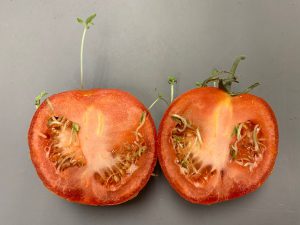
Halved tomato with interior sprouts. Photo credit: Mary Salinas, UF/IFAS Extension.
This phenomenon also commonly happens in pepper, citrus, apple, jackfruit, avocado and pear.
Yes, you can separate the little plants and plant them on their own if you would like.
For more information on growing tomatoes:
Tomatoes in the Florida Garden
Florida Vegetable Gardening Guide

by Molly Jameson | Apr 27, 2016
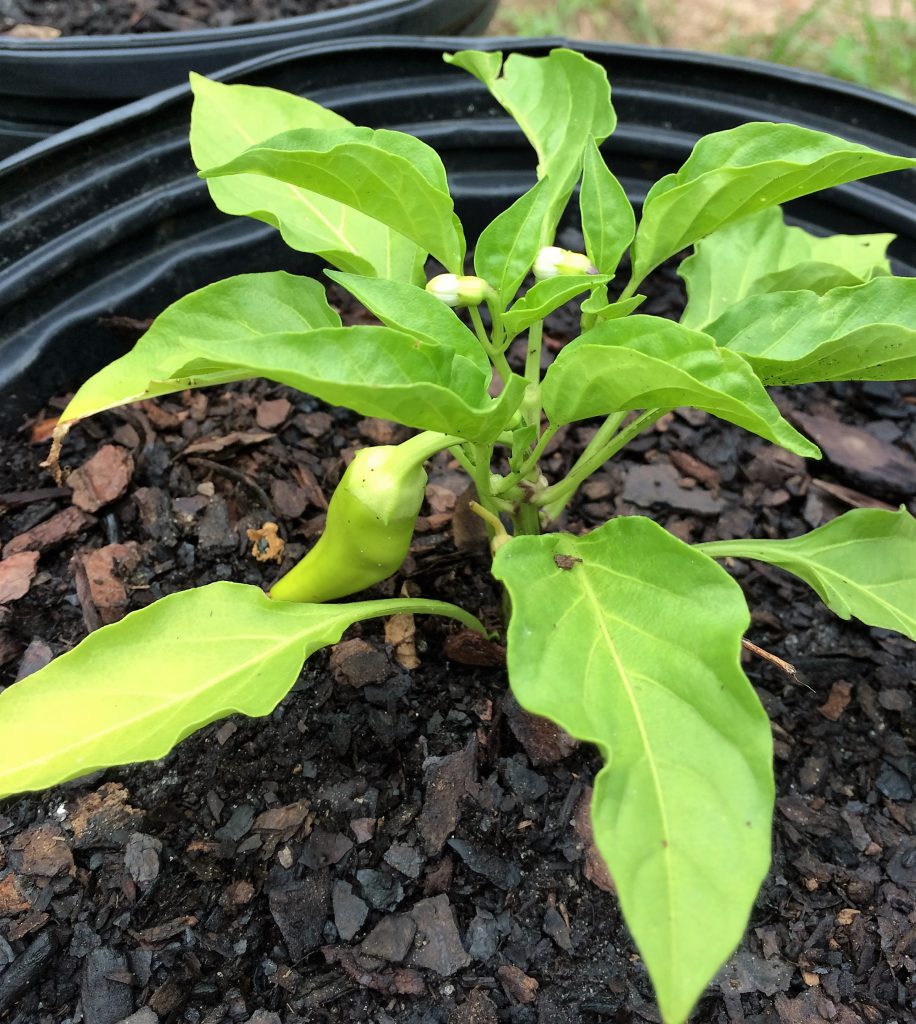
Banana pepper in container. Photo by Molly Jameson.
Interested in having a garden, but have limited space? Maybe you live in an apartment, have poor soil quality, or you just don’t have many areas that get enough sunlight. Maybe you’ve tried gardening, but given up, labeling yourself as one of those who “just doesn’t have a green thumb.” Well, I’m here to tell you, don’t give up! Try container gardening. Growing your own vegetables in containers is easy and can be a very rewarding experience. Container gardens also tend to have fewer weed, pest, and disease problems then regular in-ground gardens. Following just a few guidelines, you can have a bountiful harvest of fresh fruits, vegetables, and herbs right by your front (or back) door-step!
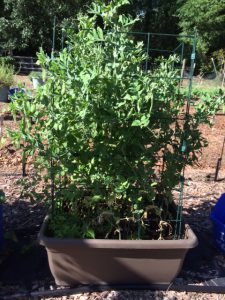
Grow vegetables easily in a large planter. Photo by Molly Jameson.
So, what are these guidelines, you ask? Well, you first want to choose the right container. This could be a large flowerpot, window box, planter, 5-gallon bucket, half-barrel, recycled material…the list can be endless. Just as long as your container is big enough and has proper drainage. Generally, the container should be at least 10 inches wide and 10 inches deep. The bigger the better, as it will give the roots more space to grow, and the soil will not dry out as fast. Tomatoes, for instance, do best in larger pots, preferably the size of a five-gallon bucket. For many herbs, you can get away with planting two or three different types in the same container. It is also important that your container has drainage holes, so water can escape and air can circulate. Use a one-fourth inch drill bit to create holes in the bottom or along the sides near the bottom of the container if it does not have holes.
Most of us know plants need both sunlight and soil. But just how much sunlight and what type of soil? If you are growing vegetables, it is best to have full sun – which means at least six hours of direct sunlight per day. An advantage of growing in containers is that you can easily place a container in an area of your yard or on a balcony that receives adequate sunlight, when it would be much more difficult to build a garden in these same areas.
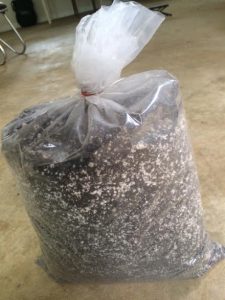
Buy potting soil in bulk to cut down on costs. Photo by Molly Jameson.
So what about soil? When growing in containers, you want to make sure you get potting soil that is made for containers. These mixes will contain materials such as peat, perlite, and vermiculite for both good drainage and moisture-holding capacity, and materials such as compost and nutrient amendments that will keep your plants healthy. You can simply ask your nursery specialist for a mix formulated to grow vegetables in large outdoor containers. If you are growing a lot of vegetables, you can cut down on costs by making your own mix. Just make sure you have a good balance of the aforementioned materials, and mix in a slow-release vegetable fertilizer, following directions on the label.
Now that you have your container, your soil, and a sunny location, it is time to get the plants. Some plants are best bought as transplants or grown from seed started indoors. Vegetables such as broccoli, collards, kale, tomatoes, eggplant, peppers, and strawberries fall into this category. Other plants, such as root crops, arugula, lettuce, spinach, mustards, beans, peas, cucumbers, squash, okra, cilantro, and basil can be started from seed directly into containers.
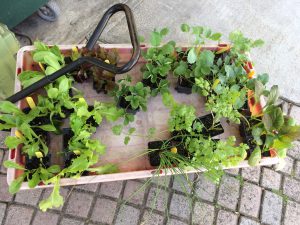
For some vegetables, buy transplants from your local nursery. Photo by Molly Jameson.
Okay, so you have all the materials. Now what? If you are growing from transplants, first thoroughly moisten the potting mix and the plant’s soil. “Transplant shock” is reduced when there is proper moisture. Set plants at about the same level they were growing in their original pot. For tomatoes, remove lower leaves and plant deeper in the container. If you are growing from seed, simply plant the seeds according to their label. A good rule of thumb is to plant the seed to a depth of about two to three times the seed’s diameter. If you are worried about your seeds not germinating, go ahead and plant more seeds than you need. But remember to thin to appropriate spacing if they do, indeed, all come up. Spacing will be specific to the type of vegetable.
After planting, water gently but thoroughly. Monitor your container garden, making sure the potting mix does not dry out. You can reduce evaporation by mulching with leaf litter, straw, or a similar material. Plants that grow tall or produce vines, such as tomatoes and cucumbers, will need support. A wire cage or pole, inserted into the container at planting time, will support the plant as it grows.
Last step is to call over all your friends and family and show off your beautiful vegetable plants! They will surely be impressed by your “green thumb” and will be eager to learn your gardening secrets.
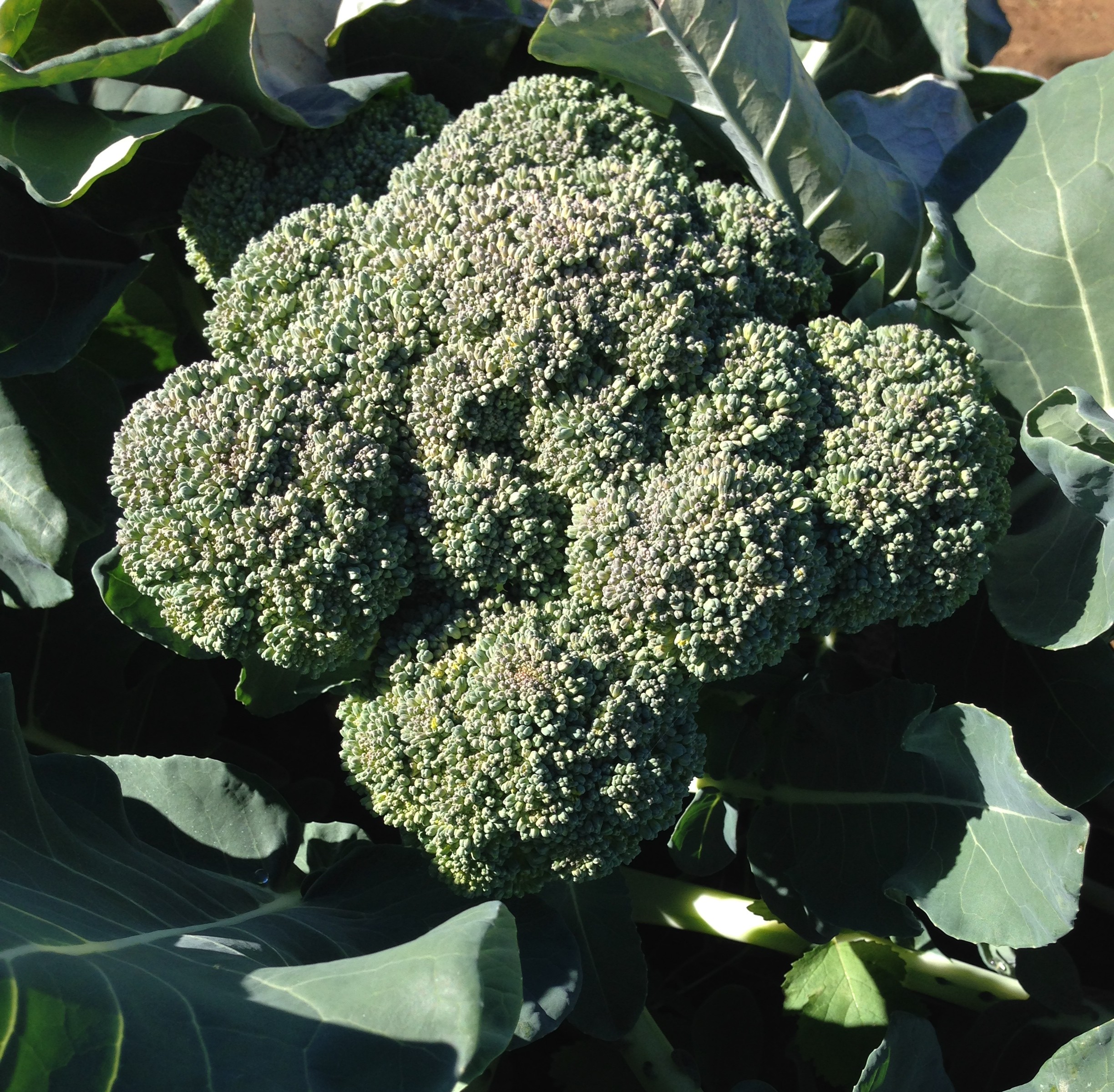
by Julie McConnell | Sep 3, 2015
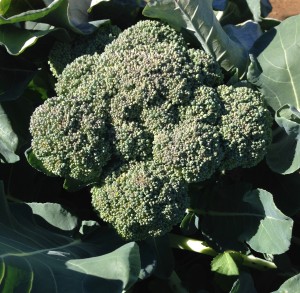
Broccoli, a popular winter vegetable. Photo by Mary Derrick, UF IFAS
As the days get shorter and temperatures decrease, it is time install your cool season vegetable garden. Many vegetables can be grown in Florida, but it is important to understand what the climatic requirements are for each crop to have the most success.
To get the most of your garden space know the recommended months for planting and the turnaround time for harvest so that you can stagger plantings or change out crops as needed.
September is the ideal time to plant cabbage, beets, kale, lettuce, mustard greens, onions, and radishes. After the New Year some options include eggplant, potatoes, English peas, and turnips.
Many gardeners start their tomatoes and peppers as early as February, but they are frost sensitive and early planting carries some risk of cold damage.
If you are interested in learning more about fall vegetable gardening, join the UF/IFAS Bay County Master Gardeners on Friday, September 18th for a free vegetable gardening workshop. This class will be held at the Bay County Extension Office at 2728 E. 14th Street in Panama City. To register please call 850-784-6105 or email bay@ifas.ufl.edu. Fall-VegMG2015
For more information and a full chart of what to plant when see Florida Vegetable Gardening Guide.
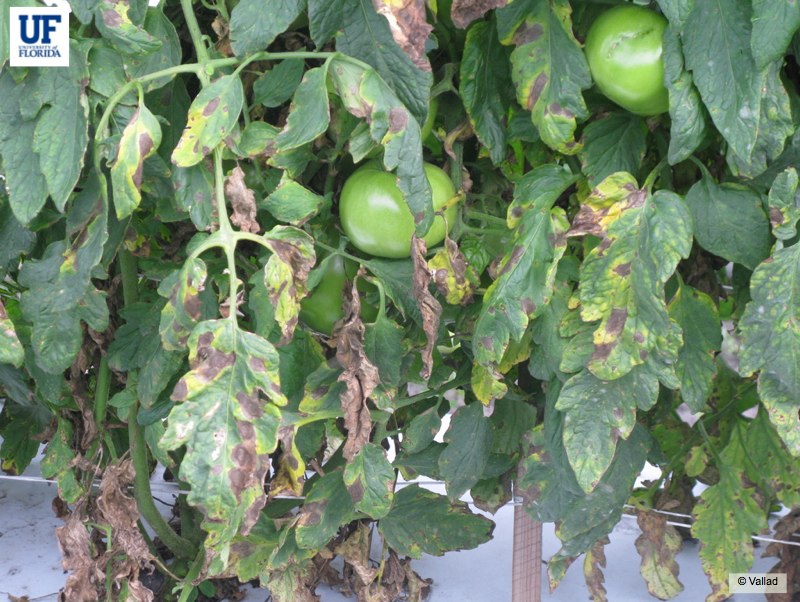
by Blake Thaxton | Apr 21, 2015
With the over abundance of rainfall the western panhandle has seen in recent weeks, tomato gardeners need to be aware of foliar diseases that could appear. Tomato leaves are an ideal host when moisture is present on the leaf surface. There are several of these diseases that, if not managed, can destroy the garden.
Early Blight

Advanced symptoms of Early Blight (Photo Credit: UF/IFAS U-Scout website)
Early Blight is a fungal disease that can affect tomato leaves and fruit. The disease is most prominent when temperatures are 80°F and excess moisture is present from rain or irrigation. The most classic system is the presence of leaf lesions that are approximately 1/2 inch in diameter.
Bacterial Spot
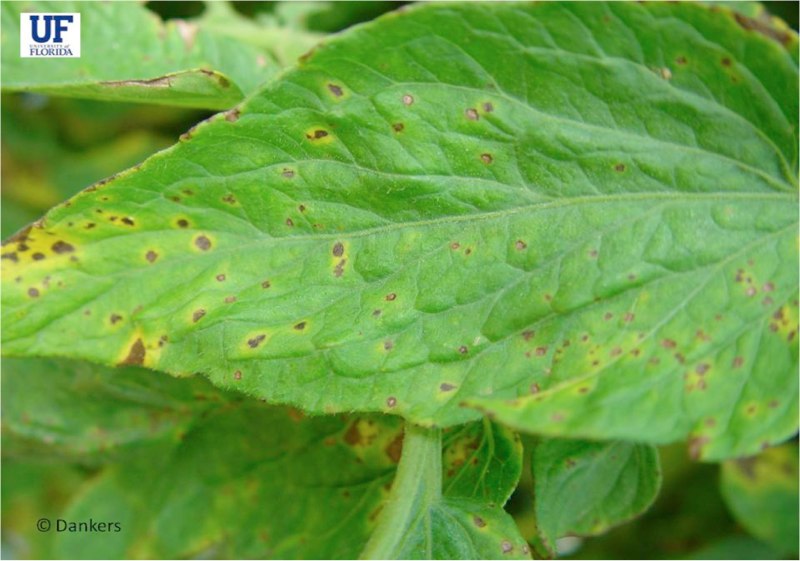
Bacterial Spot on a Tomato leaf (Photo Credit: Hank Dankers, From U-Scout)
Bacterial Spot can also cause problems for Florida tomato gardeners in rainy and high temperature periods. Generally the symptoms are darkened circular lesions on the leaves and fruit. Sometimes bacterial spot can be confused with other leaf lesion diseases. The bacterial spot will ooze when cut where as fungal type lesions will not.
How to prevent foliar diseases in tomato:
- Always start with disease free seed and transplants.
- Irrigate early in the day to minimize the time the leaves stay wet. Use drip irrigation when possible.
- Remove blighted leaves when the garden is dry. This technique should not be relied on exclusively.
- Remove and destroy crop residue at the end of the growing season. If not removed, it can become a breeding ground for disease next year.
- Rotate to different plant families that are not affected by the same diseases.
- Spray protective fungicides such as Mancozeb, Copper, and Chlorothalonil (for example sold as Daconil) when the conditions are right for disease (higher temperatures, excessive moisture, and rainfall).
If you have questions about these diseases or other tomato diseases, please comment below or call your local UF/IFAS Extension Agent.

by Eddie Powell | Jun 3, 2014
During this growing season monitor your plants and keep them healthy as a healthy plant will be able to better survive an invader attack.
Nematode populations can be reduced temporarily by soil solarization. It is a technique that uses the sun’s heat to kill the soil-borne pests. Adding organic matter to the soil will help reduce nematode populations as well. Nematodes are microscopic worms that attack vegetable roots and reduce growth and yield. The organic matter will also improve water holding capacity and increase nutrient content.
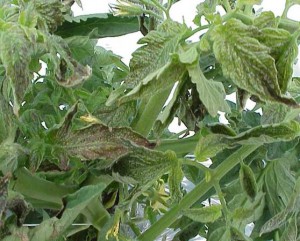
Tomato Spotted Wilt Virus
Credits: UF/IFAS
If you choose to use pesticides, please follow pesticide label directions carefully. Learn to properly identify garden pests and use chemicals only when a serious pest problem exists. If you have questions please call your UF/IFAS county extension office. We can provide helpful information about insect identification.
Organic gardeners can use certain products like BT(Dipel) to control pests. Please remember not every off-the-shelf pesticide can be used on every crop. So be sure the vegetable you want to treat is on the label before purchasing the product.
Follow label directions for measuring, mixing and pay attention to any pre-harvest interval warning. That is the time that must elapse between application of the pesticide and harvest. For example, broccoli sprayed with carbaryl (Sevin) should not be harvested for two weeks.
Spray the plant thoroughly, covering both the upper and lower leaf surfaces. Do not apply pesticides on windy days. Follow all safety precautions on the label, keep others and pets out of the area until sprays have dried. Apply insecticides late in the afternoon or in the early evening when bees and other pollinators are less active. Products like malathion, carbaryl and pyrethroids are especially harmful to bees.
To reduce spray burn, make sure the plants are not under moisture stress. Water if necessary and let leaves dry before spraying. Avoid using soaps and oils when the weather is very hot, because this can cause leaf burn.
Control slugs with products containing iron phosphate.
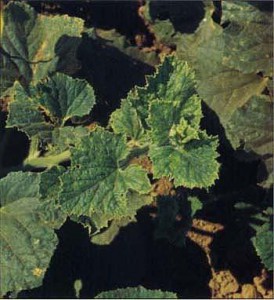
Cucumber Mosaic Virus
Credits: UF/IFAS
Many common diseases can be controlled with sprays like chlorothalonil, maneb, or mancozeb fungicide. Powdery mildews can be controlled with triadimefon, myclobutanil, sulfur, or horticultural oils. Rust can be controlled with sulfur, propiconazole, ortebuconazole. Sprays are generally more effective than dusts.















